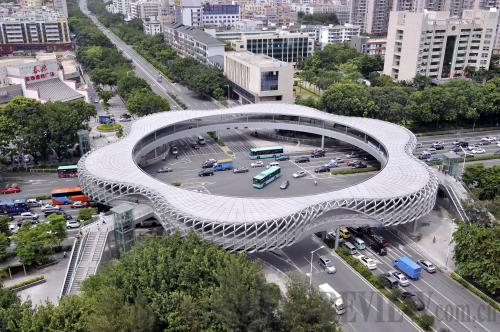|
 |
|
BURDENSOME POSSESSION: A flower-shaped overpass in south China's Shenzhen, Guangdong Province, is derided for its high costs and poor working state (LIANG XU) |
The "Gate of the Orient" is the official name of a future landmark building in Suzhou, east China's Jiangsu Province.
The 301.8-meter-high skyscraper will be 88 storeys above ground and five storeys below, consisting of hotels, offices, retail spaces and residential apartments. The two towers with a 246-meter-high arc linking them at the top will become the largest gate-shaped structure in the world after its completion at the end of this year. It was designed by the British firm RMJM and is allegedly based on the ancient city gate of Suzhou.
The structure introduces a dramatic iconic "gateway" to Suzhou and represents China's significance in the world today, according to RMJM's website.
However, the unique shape has garnered the skyscraper a torrent of online criticism. Netizens ironically call it "low-slung underpants."
Among tens of thousands of online comments mocking the structure, one Internet user said, "Are you all sure it is not Levi's new headquarters in Asia?"
"This should be called the pants of the East, not the gate of the East," complained one user on China's Twitter-like micro-blog Weibo.
A series of spoof photos containing the upper bodies of celebrities over the skyscraper, including Marilyn Monroe and the Hulk, also went viral online.
Other bloggers said that the futuristic design runs counter to Suzhou's legacy as a time-honored town with a history of more than 4,000 years.
The Gate of the Orient is not the first foreign-designed building to fall foul to the Chinese cyber world. The recently completed headquarters of China Central Television in Beijing, designed by Dutch architect Rem Koolhaas, also aroused criticism. Chinese Internet users nicknamed the structure "big shorts," and bloggers joked that Suzhou's "giant underpants" fit well with Beijing's "big shorts."
In 2007 when the National Center for the Performing Arts in Beijing was completed, its eggshell shape sparked a fierce debate on whether the futuristic design fit the surrounding environment in the heart of a city that features more formal Chinese-style architecture. The chief designer of the building was French architect Paul Andreu, who catapulted to fame after he served as the main architect of the Charles de Gaulle Airport I in the 1970s.
Some have even started to question whether foreign architects are using China to test designs that would not be accepted in other countries.
However, during a time when China is erecting buildings at a blistering pace, Chinese architectural professionals are asking the public to be more tolerant about architects' creativity and are calling on authorities to solicit public feedback during the construction of public buildings.
Harsh observations
When the perspective map of a stadium and an adjacent natatorium in Hangzhou, capital of eastern Zhejiang Province, recently came into public view, many netizens deemed the design a bit lewd as the two buildings look like a bikini bra. While the official explanation says that the two buildings symbolize the wings of a butterfly, Jin Wenyan, a lecturer at the School of Architecture and Urban Planning at Shandong Jianzhu University, said the design looks more like a pair of sunglasses.
Huang Sheng, former Dean of Shandong University's School of Architecture, said that when designing China Central Television headquarters, Koolhaas had given a lot of thought to the four-block area occupied by the building and how it would blend the media organization's facilities with its surroundings. Huang believes that a great architect like Koolhaas should be honored as much for his work as for his ideas.
| 